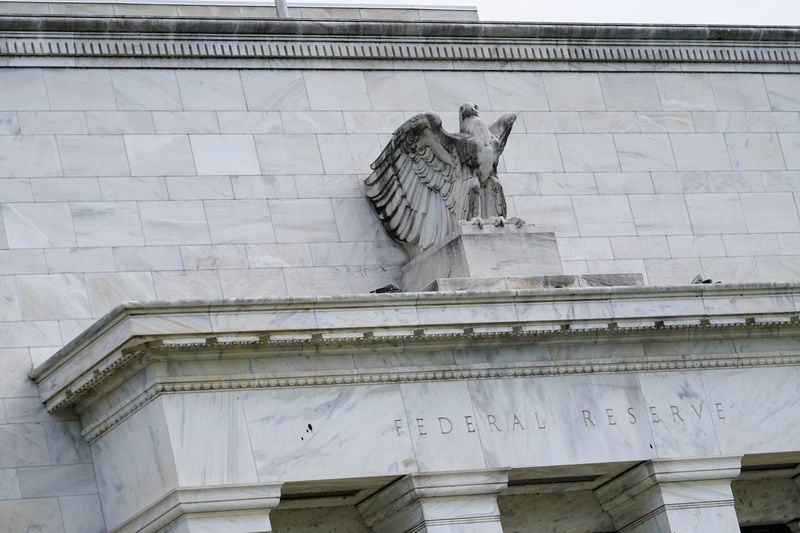
By Michael S. Derby
NEW YORK (Reuters) – Financial markets are heading into this week’s Federal Reserve meeting with more clarity over the outlook for the U.S. central bank’s ongoing balance sheet drawdown than they’ve had in a while, and those keeping close tabs on the process see it continuing into next year even as the Fed keeps cutting interest rates.
The clarity is largely tied to a new index from the New York Fed that charts pressures in short-term market liquidity. Called Reserve Demand Elasticity, it appears to front-run liquidity shortages, and in its first outing showed money markets still flush with cash. That in turn means the Fed faces no serious roadblocks to continue with the now two-year-old process of shedding bonds from its balance sheet, which is known as quantitative tightening, or QT.
“Runoff will last into (the first quarter) and perhaps even beyond, we believe, judging by the NY Fed’s new real-time Reserve Demand Elasticity measure,” analysts at LH Meyer said in a research note late last month. A New York Fed survey ahead of the September policy meeting saw QT ending in the spring of next year.
The New York Fed index and its findings go to the heart of one of the key components of the Fed’s monetary policy regime, which is to extract unneeded liquidity it had added to markets during the COVID pandemic and its aftermath.
The Fed aggressively bought Treasury and mortgage bonds starting in March 2020, first to stabilize markets and then to add stimulus when its main monetary policy tool, the federal funds target rate, was at near-zero levels.
Those purchases more than doubled the Fed’s balance sheet to a peak of about $9 trillion by the summer of 2022. That same year the Fed began to allow bonds it owned to mature and not be replaced, and it has shed about $2 trillion of those securities so far. In that recent NY Fed survey, markets reckoned Fed holdings would contract to around $6.4 trillion.
The Fed is aiming to pull out enough liquidity to enable it to retain firm control over the federal funds rate and to allow for normal periods of money market volatility. The challenge is that there is no clear way to know how far to take QT.
Fed Governor Christopher Waller said on Oct. 14 “there is no economic theory for how large a central bank balance sheet should be.” In terms of when QT might end, New York Fed President John Williams on Oct. 10 said “I don’t actually know, because it depends on what happens” with money market rates.
FRICTION EMERGES
The start of Fed rate cuts in September drove some observers to think that QT needed a near-term end to better align the two planks of monetary policy. At the same time, money market turbulence at the end of September, as the third quarter ended, pointed to unexpected tight conditions in some corners of money markets, which some also saw as a reason to shut down QT relatively soon.
But that rough turn of the quarter has not rattled Fed officials. “At present, liquidity appears to be more than ample,” Dallas Fed President Lorie Logan, a former top New York Fed official, said on Oct. 21. She added that the rise of calendar-based money market pressures “appears to reflect temporary intermediation frictions rather than shortfalls in aggregate reserve supply.”
What has been especially notable to the Fed is the level of uptake in its reverse repo facility, as well as how well the fed funds rate stays in line with levels determined by the rate-setting Federal Open Market Committee, which meets on Wednesday and Thursday in a gathering almost certain to produce a quarter-percentage-point rate cut.
The reverse repo facility is widely viewed as a proxy for excessive liquidity, and it has fallen from a peak of $2.6 trillion at the end of 2022 to $144.2 billion on Tuesday, the lowest level since early May 2021. Many Fed officials expect it to go close to zero, and from that point on QT will start eating into what have been very stable bank reserves. So far, the fed funds rate has traded exactly where the central bank wants. The two factors together have bolstered policymakers’ confidence that there remains enough liquidity to press onward with QT.
With reverse repos moving ever lower, market participants say the day the Fed will need to pull the plug is nearing. “QT will likely be a topic” at the two-day policy meeting that ends on Thursday given the state of money markets, analysts at Morgan Stanley (NYSE:MS) said.
They noted that the end of the year, usually a peak period of money market turbulence, could be pronounced due to a big Treasury debt settlement. Morgan Stanley sees QT ending in the first quarter of next year. It also expects that when the reverse repo facility gets near zero, it will be a “bumpy ride” for the market, adding that a rise in the Secured Overnight Financing Rate to close to or above the Fed’s interest on reserve balances rate, or IORB, would signal tight enough liquidity to end QT.
In the QT endgame, other variables also loom. Officials like Logan are watching the relationship of rates like the tri-party general collateral rate relative to IORB. The former rate has been below the latter, and Logan reckons money market rates as a class will in the longer run need to move above the interest on reserve balances rate.
Another factor that could signal a need to shutter QT is regular, sizable usage of the Standing Repo Facility, which provides fast cash in exchange for Treasuries for eligible financial firms. That tool got its first-ever real-world test at the end of September, and if it were to spring to life more regularly, it could signal liquidity strains that call for a change in QT.






